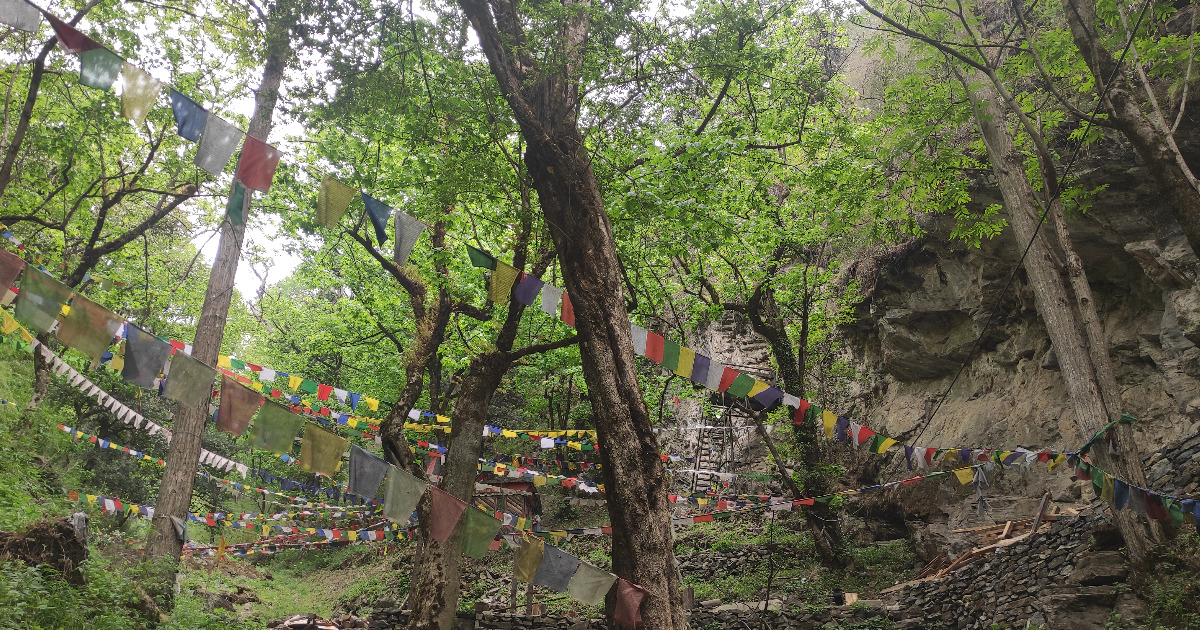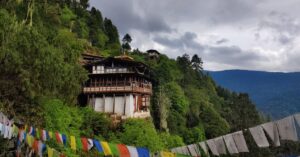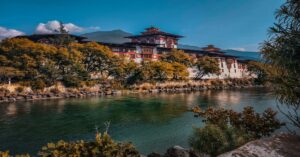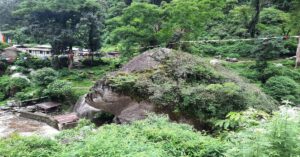Domtsang Ney is a meditative cave of Guru Rinpoche located at Bjemina, around 25 km from the capital city, Thimphu, en route to Tshelung Ney and Jagar Damkelsa Ney. The Ney is a real hidden blessing of Guru Rinpoche. It is a site of hidden blessings for all of us. The evidence left by the Guru itself is a source to revere the Ney and seek blessings.
It’s, however, at such a time when one seeks evidence and doesn’t believe blindly, it’s everyone’s responsibility to propagate the importance of our sacred legacy of Guru Rinpoche by understanding the history of holy sites throughout Bhutan, not just the Domtshang Ney.
How to Reach Dom Tshang Nye
From Thimphu, one needs to travel toward Chudzom on the Thimphu-Phuntsholing national highway. Take a diversion from Khasadrapchu towards Gidakom Hospital and keep moving. Driving through the narrow Bjemina valley roads tasseled with houses and golden paddy fields, the journey will be breathtaking. Stop at the forest depot, where you will see so many logs just after crossing the wooden bridge.
The Domtshang Nye can also be reached and visited while returning from your pilgrimage to Tshelung Ney. You can also make time to visit Jagar Damkelsa Ney, which is just near the Dom Tshang Nye.
Sacred Relics to See at Domtsang Ney
- Meditative Cave of Guru;
- Drubchhu (holy water) from a mini cave right near the road point;
- Footprint (Zhabjay) of Guru Rinpoche;
- Stone Bell hanging from the cliff;
- Self-emanated word “Aa”;
- Guru Rinpoche’s Soelthab (the Sacred Hearth);
- The sacred eye of wisdom (Yeshipai chhen).
Also Read: Guru Rinpoche in Bhutan: His Visits to Bhutan and Sacred Sites
Historical Significance of Domtsang Ney
Domtsang Ney is one of the many sacred pilgrimage sites blessed by Guru Rinpoche on his third visit to Bhutan in 876 A.D.
There are many anecdotes describing why the Ney is called Domtsang. You must get the background history right yourself. According to one oral history, Guru Rimpoche is said to have come riding a bear, meditated in, and blessed the cave. Thus, the Ney is called Domtsang, meaning “Bear’s Den”. Another story believes that Guru Padmasambhava subdued the Beast Bear that resided in the cave and terrorized the locals.
Description of Domtsang Ney
The pious pilgrimage starts as one walks upward for 15-20 minutes through the narrow path, shadowed by the thick flora that Bhutan boasts of. Climbing up a while, you can find an imprint of a tortoise and a vulture.
As one climbs further up through a zigzag path, before one reaches the main cave, one can see the footprint (Zhabjay) left by Guru Rinpoche for the benefit of all sentient beings.
As one ascends, one can see Guru Rinpoche’s Soelthab (Sacred Hearth).
Upon reaching the sacred Ney, one can find a new butter lamp-offering house built near the base of a holy cliff cave. A metallic ladder perched on the cave is meticulously nestled in the middle of the rocky cliff. Thanks to generous patrons from Bjemina, now we can be safe while climbing up to the cave nestled perilously.
A Stone Bell (choe drill) hangs from the cliff near the cave. One can ring (hit) the bell with a long stick (as it’s a bit far from a human’s height) and hear the unique sound of a bell echoing through our hearts, generating the prayers of Guru Rinpoche on our lips. There is also a Dorjee.
As one returns, don’t forget to take the Drubchhu (holy water) from a mini cave at the base of Domtshang Nye.
The Sacred Cave
Taking off shoes, one can proceed through the Sacred Cave cautiously, taking care of one’s head (the entry point is quite narrow). Inside, the cave is wide but dark, only lit by the flames of butter lamps offered by the patrons and pilgrims.
The huge sacred cave with the greatest artistic sculptures is astounding. That’s the shocking cave where one can find solace and prayers from one’s heart. One can also find a statue of Guru Rinpoche installed by the same loyal patron from Bjemina.
After one offers one’s offerings, one can prostrate for the well-being of all sentient beings. That’s the place one submits before Guru Rinpoche and pays reverence. One of the most prayer-generating treasures is the self-emanated word “Aa.”
The sacred site doesn’t end here, but one needs to be physically active to descend from the main cave and squeeze through the narrow passage within the cave. One can get blessings from Guru Rinpoche’s sacred eye of wisdom (Yeshipai chhen). One can also find a garuda on the cliff.
Best Time to Visit Domtsang Ney
Though pilgrimage to sacred places can’t have an ideal time, people choose according to the season and their convenience. Therefore, I recommend visiting Guru Rinpoche’s meditative cave while returning from Tshelung Ney. You can visit major pilgrimage sites in Thimphu with the Bhutan Pilgrimage Package.
Pro Tip: Most people who visit Tshelung Ney visit Domtsang Ney since it’s right on the way. You can also pay a brief visit to Jagar Damkelsa Ney on the way to Chimithangka and Khandro Nye.
Other Sacred Sites to Explore in Thimphu
Dechenphu Lhakhang: It is a monastery dedicated to Geynyen Jagpa Melen, a powerful protective deity, located at the northern end of the Thimphu Valley in Bhutan. The Temple was constructed in the 12th century by Dampa, the son of Phajo Drugom Zhigpo.
Pangri Zampa Monastery: It is one of Bhutan’s oldest monasteries, founded in the 16th century by Ngawang Chogyal, located 8 kilometers north of Thimphu on the west bank of the Thimphu River. The monastery now functions as Bhutan’s Royal College of Astrology, where monks study traditional astrology, and the college is responsible for determining dates for important national events.
Cheri Monastery: Also known as Chagri Dorjeden Monastery, it is the first monastery established in Bhutan by Zhabdrung Ngawang Namgyel in 1620. It is located in the Upper Thimphu Valley, about 15 kilometers north of Thimphu city, perched on a hill at an altitude of approximately 2,850 meters above sea level.
Tango Monastery: The Tango Choying Dzong was founded in the 13th century by Phajo Drugom Zhigpo and rebuilt in its current form in 1688 by the Fourth Temporal Ruler, Tenzin Rabgye. The monastery is perched on a forested hillside near Cheri Mountain, famed for its spiritual legends, particularly the prophecy involving the deity Hayagriva.
Tshelung Ney: Renowned as the “Second Draphu Maratika,” it is a sacred place of prophetic longevity where Guru Rinpoche received life empowerment (Tse Ngedrup) from Tsepakme (Amitayus) during the 8th century while meditating here for four months.
Jagar Damkelsa Ney: It is a sacred cliff where the 13th-century Mahasiddha Drubthob Nagi Rinchen meditated to save his mother from hell. The site features a historic bamboo basket and wooden beam, symbolizing his miraculous meditation, making it an important yet lesser-known pilgrimage destination.
Enjoyed reading this blog?




